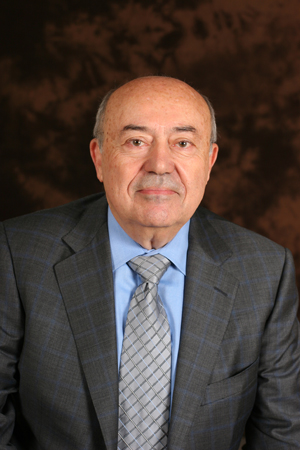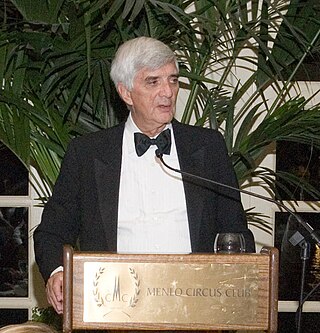Related Research Articles

Andrew James Viterbi is an Italian Jewish–American electrical engineer and businessman who co-founded Qualcomm Inc. and invented the Viterbi algorithm. He is the Presidential Chair Professor of Electrical Engineering at the University of Southern California's Viterbi School of Engineering, which was named in his honor in 2004 in recognition of his $52 million gift.

Robert Elliot Kahn is an American electrical engineer who, along with Vint Cerf, first proposed the Transmission Control Protocol (TCP) and the Internet Protocol (IP), the fundamental communication protocols at the heart of the Internet.

Robert Wendell Lucky was an American electrical engineer, inventor, and research manager at Bell Labs and Bell Communications Research (Bellcore). He is best known for his writings and speeches about technology, society, and engineering culture. Bob is a Fellow of the IEEE and a member of the National Academy of Engineering. He is also a member of TTI/Vanguard's advisory board.
Alfred Yi Cho is a Chinese-American electrical engineer, inventor, and optical engineer. He is the Adjunct Vice President of Semiconductor Research at Alcatel-Lucent's Bell Labs. He is known as the "father of molecular beam epitaxy"; a technique he developed at that facility in the late 1960s. He is also the co-inventor, with Federico Capasso of quantum cascade lasers at Bell Labs in 1994.
Richard E. Blahut, former chair of the Electrical and Computer Engineering Department at the University of Illinois at Urbana–Champaign, is best known for his work in information theory. He received his PhD Electrical Engineering from Cornell University in 1972.
Tadahiro Sekimoto was a Japanese electronics engineer, a recipient of the IEEE Medal of Honor (2004), chairman of Japan's Institute for International Socio-Economic Studies (IISE), and former chairman of the Board of Councilors of the Japan Federation of Economic Organizations (Keidanren) who served as president and later chairman of Japan's NEC Corporation (NEC). Born in Hyōgo, Japan, Sekimoto earned his BS in physics in 1948 and his Doctor of Engineering degree in 1962 at the University of Tokyo.
James Loton Flanagan was an American electrical engineer. He was Rutgers University's vice president for research until 2004. He was also director of Rutgers' Center for Advanced Information Processing and the Board of Governors Professor of Electrical and Computer Engineering. He is known for co-developing adaptive differential pulse-code modulation (ADPCM) with P. Cummiskey and Nikil Jayant at Bell Labs.
Arun N. Netravali is an Indian–American computer engineer credited with contributions in digital technology including HDTV. He conducted research in digital compression, signal processing and other fields. Netravali was the ninth President of Bell Laboratories and has served as Lucent's Chief Technology Officer and Chief Network Architect. He received his undergraduate degree from IIT Bombay, India, and an M.S. and a Ph.D. from Rice University in Houston, Texas, all in electrical engineering. Several global universities, including the Ecole Polytechnique Federale in Lausanne, Switzerland, have honored him with honorary doctorates.

Anurag Kumar was the Director of the Indian Institute of Science at Bangalore, India from 2014–2020. He is a professor at the Department of Electrical Communication Engineering, and has served as the Chairperson of the Electrical Sciences Division at the Indian Institute of Science, before being appointed as the Director in 2014.

Tingye Li was a Chinese-American scientist in the fields of microwaves, lasers and optical communications. His innovative work at AT&T pioneered the research and application of lightwave communication, and has had a far-reaching impact on information technology for over four decades.
Amos Edward Joel Jr. was an American electrical engineer, known for several contributions and over seventy patents related to telecommunications switching systems.
Stewart David Personick is an American researcher in telecommunications and computer networking. He worked at Bell Labs, TRW, and Bellcore, researching optical fiber receiver design, propagation in multi-mode optical fibers, time-domain reflectometry, and the end-to-end modeling of fiber-optic communication systems.
Krishan Sabnani is an Indian-American networking researcher. He has made many seminal contributions to the Internet infrastructure design, protocol design, and wireless networks. Krishan made a breakthrough in Internet re-design. The main idea behind this work was to separate control functions and complex software from the forwarding portions on Internet routers. This work made it possible for forwarding technologies to evolve and be deployed independently from control protocols. This contribution is a precursor to the current Software Defined Networking (SDN) revolution. A patent based on this work won the 2010 Edison Patent Award.
Joel Stanley Engel is an American electrical engineer who made fundamental contributions to the development of cellular networks.
John O. Limb is an Australian engineer, known for fundamental contributions to the development of digital video communications and holder of a series of patents related to computer communications.
Jesse Eugene Russell is an American inventor. He was trained as an electrical engineer at Tennessee State University and Stanford University, and worked in the field of wireless communication for over 20 years. He holds patents and continues to invent and innovate in the emerging area of next generation broadband wireless networks, technologies and services, often referred to as 4G. Russell was inducted into the US National Academy of Engineering for his contributions to the field of wireless communication. He pioneered the field of digital cellular communication in the 1980s through the use of high power linear amplification and low bit rate voice encoding technologies and received a patent in 1992 for his work in the area of digital cellular base station design.

Richard H. Frenkiel is an American engineer, known for his significant role in the early development of cellular telephone networks.

John Mathew Cioffi is an American electrical engineer, educator and inventor who has made contributions in telecommunication system theory, specifically in coding theory and information theory. Best known as "the father of DSL," Cioffi's pioneering research was instrumental in making digital subscriber line (DSL) technology practical and has led to over 400 publications and more than 100 pending or issued patents, many of which are licensed.
Mischa Schwartz is the Charles Batchelor Professor Emeritus of Electrical Engineering at Columbia University, which he joined in 1974 as professor of electrical engineering and computer science. He received the B.E.E. degree from the Cooper Union, New York, NY, in 1947, the M.E.E. degree from the Polytechnic Institute in 1949, and the Ph.D. degree in applied physics from Harvard University under the supervision of Philippe Le Corbeiller in 1951. He was the founding director of the NSF-sponsored Center for Telecommunications Research (CTR). He is a Life Fellow of the IEEE, and a Fellow of the AAAS. In 1992, he was elected a member of the US National Academy of Engineering for leadership in engineering education in the field of communications. He is also a past president of the IEEE Communications Society, and a former Director of the IEEE.
Nambirajan Seshadri is a professor of practice at the Department of Electrical and Computer Engineering, Jacobs School of Engineering, University of California, San Diego.
References
- ↑ New president named at Bell Labs from New York Times (July 2, 1991).
- ↑ biography from IEEE
- ↑ presidential page from Lucent
- ↑ TheProfessionalEngineer.com
- ↑ "from ncsu.edu". Archived from the original on 2010-06-12. Retrieved 2010-08-31.
- ↑ TheProfessionalEngineer.com